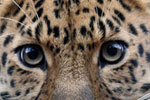In the remote Russian far east, amid pine forests and long winters, a great cat may be beginning to make a recovery. A new survey estimates that the Amur leopard (Panthera pardus orientalis) population has risen to as many as 50 individuals. While this may not sound like much, it’s a far cry from a population that may have fallen to just 25 animals. Sporting the heaviest coat of any leopard, the Amur leopard largely hunts hoofed animals, such as deer and boar, in a forest still ruled by the Siberian tiger.
“While we cannot help but be gladdened by this fact, it is no reason to let down our guard. 50 is still a critically small number for long term persistence of population,” WWF-Russia writes in a news release.
Counting Amur leopard tracks along snowy trails, scientists counted 23 individuals, leading to a total estimate of a minimum of 43-45 Amur leopard adults and 4-5 cubs in the wild. This is around a 50 percent increase from the last survey in 2007, which estimated 27-34 animals total. The researchers also found that the leopards were expanding and shifting their range as the population grew.
Most of the leopards are in Russia, however recent camera trap photos have shown a few individuals on the Chinese side of the border. Sightings have also been reported from North Korea.
“The Far Eastern leopard, the rarest cat on the Earth, is stepping back from the brink,” says Yury Darman, Director of the Amur branch of WWF-Russia. “We had started the recovery program in 2001 and now can be proud of almost 50 leopards in the wild. The most crucial role is played by the establishment of large unified protected area with huge state support, which covers 360 thousand hectares of leopard habitats in Russia. It is necessary now to accelerate the creation of a Sino-Russian transboundary reserve that would unify six adjacent protected areas encompassing 6,000 square kilometers.”
Amur leopards are imperiled by poaching, habitat loss, and inbreeding. Poachers not only target the leopards, but also the prey base on which they depend. However, conservationists say there may be a new rising threat to the tiny population: Siberian (or Amur) tigers (Panthera tigris altaica).
Siberian tiger numbers are also increasing in the region, leading to clashes between the two predators. The world’s largest cat, Siberian tigers can weigh up to 6 times the Amur leopard and are easily a lethal match for the smaller cat. In fact, WWF-Russia reports that in the past few years they have found three Amur leopards killed by tigers. WWF-Russia says more research is needed on the relationship between these two great cats.

Amur leopard, (Panthera pardus orientalis) snarling in snow. Captive. Photo by: Lynn M. Stone/WWF.
Related articles
Conservationists turn camera traps on tiger poachers

(11/12/2012) Remote camera traps, which take photos or video when a sensor is triggered, have been increasingly used to document rare and shy wildlife, but now conservationists are taking the technology one step further: detecting poachers. Already, camera traps set up for wildlife have captured images of park trespassers and poachers worldwide, but for the first time conservationists are setting camera traps with the specific goal of tracking illegal activity.
Russia creates massive park for rare cats
(04/13/2012) Russia has created a massive national park to protect some of the world’s rarest big cats, the critically endangered Amur tigers and leopards, reports the Wildlife Conservation Society (WCS).
Russia, South Korea sign agreement to resurrect woolly mammoth

(03/19/2012) Last week Russian and South Korean educational facilities signed an agreement to work together to bring back the woolly mammoth (Mammuthus primigenius) from extinction. The project will be headed by Hwang Sooam of South Korea’s Bioengineering Research Institute and will involve implanting a woolly mammoth embryo into a modern elephant.

(10/13/2011) The Amur leopard has been confirmed in China with a camera trap taking the first photos of the cat in the country in 62 years, reports Xinhua. The Amur leopard (Panthera pardus orientalis) is on the edge of extinction with some 25-45 individuals left in the world. The Amur leopard was photographed twice by camera trap in Wangqing County, China by Sun Ge, a PhD candidate with Peking University. Technically, the Amur leopard, also known as the Manchurian leopard, is considered extinct in China.
Tiger summit reaches bold agreement and raises $300 million
(11/24/2010) The summit to save the world’s biggest cat, and one of the world’s most popular animals, has agreed to a bold plan dubbed the Global Tiger Recovery Program. Meeting in St. Petersburg, 13 nations have set a goal to double the wild tiger’s (Panthera tigris) population worldwide by 2022. Given that tiger numbers continue to decline in the wild, this goal is especially ambitious, some may even say impossible. However, organizations and nations are putting big funds on the table: around $300 million has already been pledged, including $1 million from actor, and passionate environmental activist, Leonardo Dicaprio.